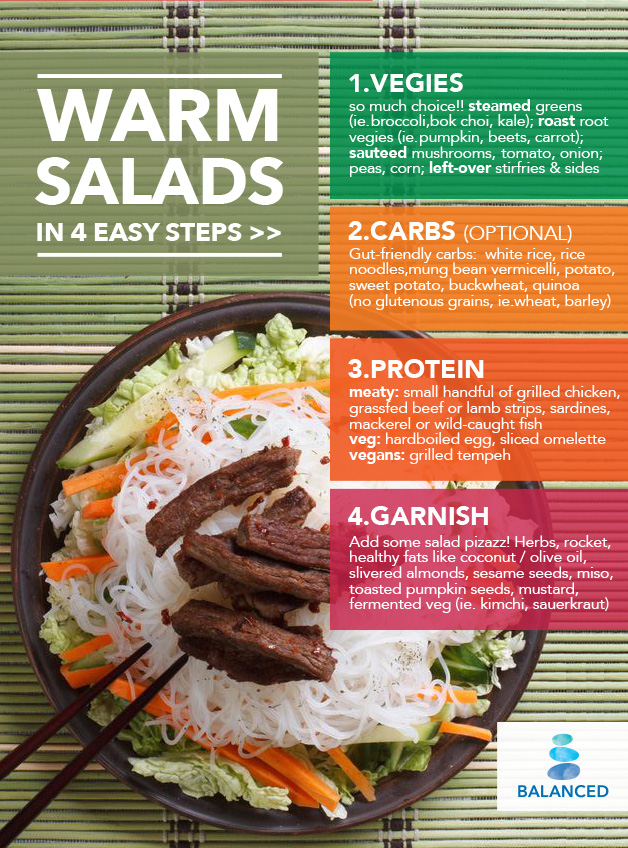One of the more common questions asked by patients is “what can I eat?”. Food is an important part of healing, and it is interesting to note the differences between the Chinese and Western ideas of health foods. In the West, many may consider raw food, salads, juices, smoothies and fruit to be the ultimate health foods, while Chinese Medicine focuses on foods that support digestion and can therefore be fully utilised by the body. While it is true that “you are what you eat”, it would perhaps be more correct to say that “you are what you can digest” – a digestive system that is operating at less than optimal levels will leave patients feeling tired and heavy, as undigested food lingers in the system and throws out intestinal health. As digestion is at the foundation of treating conditions as diverse as asthma, IBS, allergies and arthritis, the foods that we choose to eat will play a big role in healing. To support digestive health, Chinese Medicine recommends warm, cooked foods (and no cold drinks!). This can be quite a departure initially for some patients, so we will be posting some food and recipe ideas to inspire you in the kitchen!
One quick and easy way to make your salads Chinese-Medicine-friendly is to convert them to warm salads – perfect in summer and winter! Salad combinations are limited only by your imagination, but here are a few ideas to get you started.
Step 1. Vegies
Obviously an essential component of any good salad! Some options to consider are steamed greens, such as broccoli / chinese broccoli / broccolini, asparagus, kale, silverbeet, green beans, etc. If you are feeling like a more hearty base to your salad, incorporate some roast vegies like beetroot, pumpkin, squash, potato and carrots. If you’re feeling adventurous you could trying roast celeriac, parsnip and turnips. Or sautee some tomatoes, zucchini, mushroom or onions – whatever takes your fancy! Warm salads are also a great way to use up leftover stirfries or sides from last night’s dinner.
Step 2. Carbs (optional)
If you want carbs in your salad, choose from gut-friendly and gluten-free carbs such as potato, sweet potato (avoid this if you have been diagnosed with “Damp”), buckwheat or quinoa. Rice noodles or mung bean vermicelli are an easy addition, and only require soaking in hot water for a few minutes (no cooking!). White rice can also be incorporated in your salads – Chinese Medicine does not recommend brown rice, which contains a tough outer husk that does not break down during digestion and can irritate sensitive systems. It is informative to note that all cultures in which rice is a staple use only white rice for this reason, despite the greater labour involved in husking brown rice.
If you are going carb-free, just increase the amount of vegies in Step 1.
Step 3. Protein
Time to add some protein. This should form around 20% of your meal rather than being the main event. For vegans, try some grilled tempeh or tofu; vegetarians can add hard-boiled eggs or omelette strips. For the meat-eaters out there, try adding some strips of grilled chicken breast, grassfed beef or lamb; if you’re feeling like seafood, try sardines, smaller mackerel or prawns. While tuna and salmon may seem like a good choice too, their larger size means that they can accumulate a greater toxic load over their lifetimes, so try to limit consumption of these bigger fish.
Step 4. Garnish.
You’re almost done, so it’s time to add some pizazz to your warm salad! Again, the choices are endless but can include things like healthy fats such as coconut or olive oils (avoid vegetable oils, which can be pro-inflammatory), balsamic vinegar, mustard and small amounts of nuts or seeds, such as toasted pumpkin seeds, sesame seeds, slivered almonds or crushed peanuts. Herbs are an excellent source of anti-oxidants, the nutritional ninjas that fight off the free radicals that damage body cells. Bonus points for including naturally-fermented vegies such as sauerkraut or kimchi! These contain beneficial bacteria to further support intestinal health (though make sure to add these at the end of your salad and don’t heat them, as this will kill off the good bacteria). Miso paste is also full of good bacteria and can add some great flavour to your salads.
Bringing it all together
As we’ve seen, the combinations and choices are endless, but a few of our favourite combos are:
• steamed chinese broccoli & snow peas + rice vermicelli + chicken strips + fish sauce (fermented goodness!), coconut oil & slivered almonds
• grilled corn, capsicum & tomato + quinoa + tempeh (cooked in cumin, salt & pepper) + avocado, coriander & olive oil
• roast beetroot + sweet potato + lamb strips + rocket, balsamic vinegar, mustard & olive oil
• wilted silverbeet + roast potato + grilled sardines + dressing (olive oil, lemon, garlic, shallots, salt, black pepper)
• grilled eggplant (with garlic & ginger) + beef strips + miso + sesame seeds, spring onion
Run out of time?!
Life gets a bit crazy sometimes, but the good news is that there are lots of places that we can get a warm salad on the go. In addition to your local cafe or paleo restaurant, you can get inexpensive warm salads at places like Spud Bar, Salsa’s, Mad Mex and Sumo Salad (just ask them to warm it up for you).
We’d love to hear your winning warm salad successes, so please share your ideas in the comments section below!

